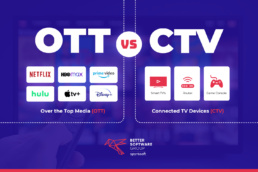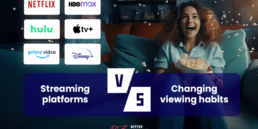Advertising through various platforms is crucial for marketers and advertisers. The two key players in this space are OTT and Connected TV (CTV) advertising. Many people mistakenly use these phrases interchangeably, but they are actually not the same thing. To effectively create a multichannel advertising strategy, you need to know what distinguishes each type of advertising. You’re in the right place!
Short overview of OTT and CTV and the main difference
OTT means the delivery of film and television content over the Internet, without the need for users to subscribe to a traditional cable or satellite pay TV service. Popular platforms such as Netflix, Hulu and Amazon Prime Video are the best examples of OTT services. OTT content can be accessed on a variety of devices, including desktops, computers, smartphones and tablets.
CTV, on the other hand, involves delivering content to your TV through a connected device such as a Smart TV, gaming console, or a streaming device such as a Roku or Apple TV. Here we exclude devices such as computers, smartphones, or tablets.
OTT and CTV are often used interchangeably, but there is a difference between them.
It is important to remember that OTT is a method of delivering video content, while CTV is a physical device that can play such content. For example, you can watch OTT content – like your favorite Amazon Prime series – on a CTV device like a Samsung Smart TV. CTV refers only to TV screens.
OTT vs. CTV Advertising: A Comparative Analysis
By understanding the distinctions and strengths of each platform, advertisers can make more informed decisions about where and how to allocate their advertising efforts for maximum impact.
Targeting your audience
OTT Advertising: OTT platforms collect a lot of data about viewers’ individual behavior, preferences and interests. This includes viewing history, search queries, and interaction with different types of content. Using this data, OTT enables advertisers to create highly personalized ads. For example, a viewer who frequently watches cooking shows may see advertisements for kitchenware or grocery delivery services.
CTV Advertising: CTV ads are typically targeted at the household level, using data on household demographics and collective viewing patterns. This is more in line with traditional TV advertising, but with a digital twist. CTV isn’t as detailed as OTT, but it still offers contextual and behavioral targeting. Advertisers can place ads on content that aligns with their target audience’s interests or at specific times when their audience is most likely to view them.
Ad formats and viewer experience
OTT Advertising: OTT platforms support a wide range of ad formats. This includes standard video ads, interactive ads that viewers can engage with, sponsored content that connects to regular programming, and display or banner ads that appear while viewing content.
OTT ads often integrate seamlessly into the viewing experience. For example, native advertising can be incorporated into content in a natural and less intrusive way.
CTV Advertising: CTV primarily uses traditional television advertising formats but uses digital targeting to increase the relevance of these ads to households or audience segments. Most CTV ads are non-skippable, ensuring that viewers watch the entire ad. Ads are typically displayed in full screen, which creates a more immersive and immersive experience, especially on larger TV screens.
Measurement and analytics
OTT Advertising: OTT platforms provide detailed data on viewer behavior, including what, when and for how long they watch content. This level of detail covers ad interactions, offering insight into viewer engagement with specific ads. Additionally, metrics often focus on the relevance and effectiveness of these personalized ads. The key metrics are engagement rates, click-through rates, and conversion rates.
CTV Advertising: CTV ads often focus on household-level data, providing insight into the viewing habits and preferences of a broader audience. This may include data about the types of programs watched and prime viewing times. CTV analytics highlights an ad’s reach (how many households it was shown to) and frequency (how often it was shown). These metrics are similar to traditional TV ads, but with added precision.
Audience reach and engagement
OTT Advertising: OTT platforms have the unique advantage of transcending geographical boundaries to offer content that appeals to audiences around the world. This includes niche markets that are often underserved by traditional media, allowing advertisers to target specific interest groups or demographics with highly tailored content. OTT platforms are particularly popular among younger demographics who prefer streaming services to traditional TV. This gives advertisers the opportunity to reach millennials and Gen Z, who are often harder to reach through traditional media.
CTV Advertising: CTV combines the wide reach of traditional television with the additional benefits of Internet connectivity. It is ideal for reaching a wide range of demographics in one household, making it suitable for family-oriented brands and products. The larger format of CTVs increases viewer engagement, especially with visual content and advertising. This can lead to greater brand awareness and influence.
User interaction
OTT Advertising: OTT platforms often enable more direct user interaction with ads. This may include clickable ads, where viewers may click on the ad to obtain more information, make a purchase or be redirected to a website. Given the personalized nature of OTT viewing, users can interact with ads in a more personalized way. For example, they can choose which ad to watch or skip ads that are less interesting to them. Some OTT ads take the form of interactive content such as mini-games or quizzes. These formats can significantly increase engagement and make your ads more memorable.
CTV Advertising: Interaction with CTV ads tends to be more passive, like traditional TV advertising. Viewers watch these ads mainly without the opportunity to interact directly, such as clicking or selecting. Most CTV ads are unskippable, ensuring that the ad is viewed in its entirety. This can lead to better brand awareness as viewers are more likely to watch the entire ad without distraction. Some CTV platforms are starting to experiment with interactive features, such as on-screen QR codes that viewers can scan with their mobile devices to increase engagement with ad content.
Challenges and considerations in OTT and CTV Advertising
While OTT and CTV advertising present significant opportunities, they also come with their own set of challenges and considerations. Addressing these is crucial for advertisers to maximize the effectiveness of their campaigns.
Content overload
The sheer amount of content available on OTT and CTV platforms can lead to an overload for audiences who are overwhelmed with choices. This can make it difficult for your ads to stand out and attract attention.
High costs of producing high-quality content
Creating high-quality advertising content, especially for CTV, can be expensive. The key issue is balancing the need for effective advertising with budget constraints.
Ad Fatigue
As exposure to digital advertising increases, viewers may experience ad fatigue and, as a result, become desensitized to advertising messages. To combat this, it is essential to create fresh, innovative, and engaging content.
Personalization and privacy
While personalized ads may be more effective, concerns about privacy and data use are growing. Advertisers must approach these issues carefully to maintain viewer trust when delivering targeted content.
Why OTT and CTV advertising shouldn’t be neglected
OTT and CTV advertising are the essential components of a modern advertising strategy. Traditional TV viewing is rapidly being displaced by streaming services and online content platforms. To stay relevant and reach audiences where they are most active, advertisers need to adapt to these changing habits. In the U.S., 88% of households owned at least one internet-connected TV device in 2023, and the number of CTV users among Gen Z and Millennials exceeded 110 million. When it comes to OTT, OTT video advertising was projected to reach a market volume of $205.10 billion USD in 2023, making it the largest segment of the industry.
These figures highlight the growing dominance and potential of OTT and CTV advertising. These platforms are becoming a key component of effective advertising strategies, particularly able to reach younger, technologically unfamiliar audiences. The significant investment and measurable impact of OTT and CTV advertising highlights their effectiveness in engaging audiences, influencing consumer behaviour and driving market trends.
For advertisers and brands, the conclusion is clear: integrating OTT and CTV into their advertising offerings is essential to remain competitive and effectively reach a diverse and growing audience in the digital age. Ignoring these platforms means missing out on significant opportunities to connect with a large and increasingly important segment of the consumer market.
The final thoughts
To sum up the topic of OTT and CTV advertising, it is clear that these platforms are a real must-have for marketers. OTT platforms, with their ability to offer highly personalized ads based on detailed viewer data, represent a new frontier in targeted marketing. These platforms allow advertisers to create campaigns that deeply resonate with viewers’ individual preferences and interests. On the other hand, CTV extends the reach of these digital strategies into living rooms, offering a combination of the broad appeal of traditional TV with the added precision of digital targeting. This combination provides a powerful tool for advertisers to engage a wide range of household demographics.
Looking to the future, OTT and CTV advertising will continue to play a key role in the way brands connect with audiences. Advertisers who use these platforms, understanding their unique strengths and challenges, will be well placed to succeed. The key will be to create engaging, relevant and effective ads that resonate with the modern viewer, who is increasingly looking for entertainment and information on streaming services.
If you find this article valuable, you can share it on social media →
Read more about the VOD & OTT Industry!
April 25, 2024
What is Connected TV and why is it becoming so popular?
Discover the benefits of Connected TV as it transforms entertainment by delivering internet-powered content through smart TVs and streaming devices.
March 7, 2024
7 reasons why is sports streaming becoming so popular
Learn more about the reasons why sports streaming is becoming more and more popular right now.
February 29, 2024
Why should streaming platforms adapt to changing viewing habits?
Discover the strategies through which streaming platforms adjust to changing viewing habits.
Are you looking for a partner to build a Video Solution?
Leave your email and a short description about your project. We would gladly discuss different cooperation possibilities!





